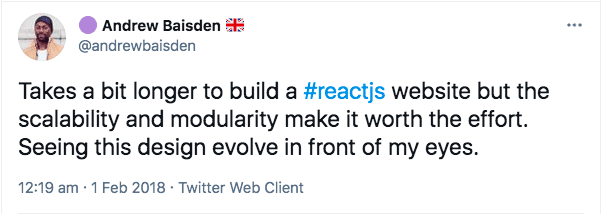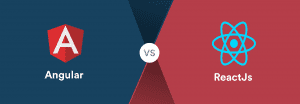Bootstrap vs React: A Comparison of 12 Principal Components
Bootstrap is often referred to as an open-source frontend toolkit, while Reactjs is a JavaScript library for building UI. With the building popularity and an emerging market share of Bootstrap, it has proved to be a good competition against React.
With distinct qualities, characteristics, and features in each of these frameworks, the question that comes to our mind is, “Which one is the optimal framework for our project?”
In this blog, Hiren talks about Bootstrap and React by comparing both the frameworks and outlining 12 critical criteria you would need to consider for creating the best web application, and if you want professional assistance in choosing one for your project, consider Simform’s web application development services.
What is Bootstrap? – An Overview
Bootstrap, also known as Twitter Bootstrap, is an open-source front-end CSS framework used to create responsive mobile-first websites. The front-end framework template for Bootstrap is primarily based on CSS. It has become a popular UI development framework for its responsive design templates, frameworks, grids, and most importantly, multi-site compatibility.
Mark Otto and Jacob Thornton developed this framework with the idea of standardizing the use of a framework by Twitter employees. This is how the framework came to be known as Twitter Bootstrap. In 2011, the developers launched this project on GitHub for everyone’s access.
Market Usage Statistics
Here are some interesting market usage statistics of Bootstrap:
- As of May 2022, approximately 4.25 million people have downloaded Bootstrap for web development.
- Till May 2022, Bootstrap is used by 21.7% of all websites amongst the JavaScript libraries.
- In terms of popularity and traffic, Bootstrap holds 2nd position with 14.38% of the market share.
Use Cases of Bootstrap
- Microblogging applications
- Social media applications
- Video streaming applications
- E-commerce websites
- Content-based website
- Geo-location applications
- On-demand applications
- Payment applications
- Messaging service web app
- Responsive web applications
Popular Apps Built with Bootstrap
- Vogue – The fashion magazine uses Bootstrap for its flat responsive website templates, making the site compatible with all devices. It also uses Bootstrap’s 12 grid layout to fit in various content-based details within a single screen.
- Apple Maps Connect – Apple uses MapKit JS for creating its interactive maps for multiple platforms. The Mapkit JS employs Bootstrap to build its user interface designs.
- Lyft – The ride-sharing company utilized Bootstrap’s grid features along with the drop-down plugins for their website. The framework also helped in the website’s development within a short span of time.
- Paypal – The online payment processing website uses Bootstrap’s Pricing Sliders to create the payment forms while checking out, adding cards, or paying bills through the site.
- Whatsapp – The user interface of Web Whatsapp has been created using Bootstrap for better interactive features and facilities over the desktop application.
What is React? – An Overview
Reactjs is an open-source Javascript library to build web apps with rich user interfaces. React offers developers the flexibility to create reusable custom components that encourage rapid development processes. Furthermore, its ability to allow quick rendering of a web page makes it more search engine friendly. All in all, it’s a great library that promotes the development of lightweight and complex business applications.
Market Usage Statistics
Here are some cool market usage statistics for React js:
- React js is used by 60 percent of the developers, according to the 2018 State of Developer ecosystem survey.
- React tops the list of “Most loved frameworks of Stackflow 2021” for almost 71 percent and features “Topmost wanted frameworks” by StackOverflow at 22.4 percentage.
- The framework boasts over 183k Github stars along with the continuously progressive community.
Use Cases of React
- Web apps (React.js)
- Video streaming platforms
- Media sites
- Software as a Service tools
- Mobile apps (React Native)
- Desktop Apps (React + Electron.js)
- Progressive Web Apps (React + Ionic)
- JAMstack sites (Gatsby.js)
Popular Apps Built with React
- PayPal- The renowned Finance organization used Reactjs to improve the navigational workflows, bookmarks, and initial rendering of their payment gateway application.
- The BBC– The well-known British public service broadcaster BBC news channel used Reactjs to build their web more navigational towards a mobile-first page, offering a super-fast user experience and making their website super accessible across all the devices.
- Facebook– The largest social media network website globally uses Reactjs currently in their Facebook Ads Manager; however, the Facebook web app is built with more than 20000 Reactjs components.
- Netflix- The famous video streaming website used React to fix the performance issues and minimize processing times for a blazing startup speed and seamless user experience.
- Twitter– The largest American microblogging and social networking service website uses React to update content, improve user experience, and create browser-based UI. They renovated their site front-end architecture with React and came up with the progressive web app version.
Bootstrap vs. React – Pros and Cons
Before you choose a framework, it’s important that you understand the opportunities and shortcomings it brings along. This comparison between Bootstrap and React should help you select the most compatible technology for your application.
Pros of Bootstrap
- Responsive design – Provides the necessary features of creating a user interface that is responsive in styles and structures and is compatible with multiple platforms.
- Time-saving – Provides excellent documentation on each component, and its readily available resources help omit the process of writing codes and debug the sites quickly. The CSS preprocessor, LESS, can be used to save time on the custom development process.
- Styling Components – Provides various user templates, themes, and plugins and a grid system that are free and customizable as per project requirements.
- Consistency and Compatibility – Excellent CSS and Javascript compatibility enables excellent cross-browser consistency
- Substantial community support – A free and open-source framework available on Github with significant community support contributing to its development.
Cons of Bootstrap
- Similar website templates – Usually criticized for having limited templates, making websites and applications made with Bootstrap look the same. Avoiding this similarity might require extensive manual customization which can be time-consuming and beats the purpose of using this framework.
- Learning curve – Developers may have to invest some time, though depending on their prior knowledge of frontend technologies, to learn more about the class components and combinations.
- Rewriting and Overriding – Significant amount of customization might lead to deviation from the customary Bootstrap designs, creating compatibility and consistency issues.
Pros of React
- Efficient web pages – React apps save a lot of time and increase web pages’ efficiency by refreshing the user interface to update the data, eliminating the need to reload the web pages.
- Better user experience – Organizes the code for future optimization and increases the readability of the code. Hence, easy dead code elimination results in a better user experience and loading speed.
- Reusability of Components – Separate logic and controls help build reusable components. Making application development faster and easier, more comfortable nesting of components to build complex functionalities.
- High Performance – It eliminates the need to update data in the real structure and uses a virtual structure to update the data. This mechanism produces high-performing React apps, no need to take the extra load while loading the web pages, faster response times, and a smooth client-side experience.
- Large Community – React js possess a robust community worldwide. From beginners to experienced developers, everyone enjoys building apps with maximum reusability of components that React offers.
Cons of React
- Continuous updates – React is frequently associated with the latest updates on all versions and contributions around the world. Hence, the Javascript library is less conventional and more evolving in coding practices.
- Increased complexity of code – JSX is an extension of the syntax used by React js that combines Javascript and HTML. It’s a little old school, an intricate pattern for developers. Also, it is a bit hard to learn as compared to learning plain Javascript.
- Only focuses on View – Building an application with Reactjs will only focus on the view layer from the model, view, and controller architecture. So you’ll have to use an additional platform for the other parts of the application. It means further integration of tools such as routing or APIs.
Bootstrap vs. React – Performance Comparison
While performance should not be a killer factor for small projects, it becomes extremely important to consider when building complex and large projects. With that being said, let’s compare Bootstrap and React in terms of performance.
How does Bootstrap stand out in terms of performance?
Bootstrap is known for its user-centric ease for developing websites and web applications, but when it comes to performance, one has to keep a close eye on it. Developers have often criticized the framework for its vast library and unutilized resources, leading to slower performance. But, what they miss is that it also offers extensive customization features to increase the app’s performance, irrespective of it being content-heavy.
Utilizing requirement-specific resources reduces the bulk over the website, such as using the source code rather than the entire library. Minimal and lean use of CSS and JavaScript codes minimizes the load on the downloading browser and increases efficiency while displaying. Other common workarounds would include compressing images, moving the server closer to the audience, and using a CDN for a high-performance loaded website. With the best practices, Bootstrap can have a lower fully loading time of 2.1 seconds of a page size that is 1.3 MB.
How does React stand out in terms of performance?
React app’s performance is faster, a lightweight performance in user experience with individual components working in a fine functional manner. The component-based architecture of React helps build more robust single-page apps, reusability removes the code clutter, and reduced DOM manipulation speeds up the page loading. All this adds to seamless app performance and a pleasing user experience.
More so, the library works on updating the necessary changes to the webpage without reloading the entire page. So, it eliminates the unnecessary loading of pages and instead refreshes the data. You could use the minimal approach to build React apps by setting some programming practices at hand. For example, DRY (Don’t Repeat Yourself) principle helps developers to make minimal mistakes and enhance team productivity.
Bootstrap vs. React – Application Architecture
When choosing a framework, it’s important to choose flexibility and avoid any strict enforcement of architecture and guidelines. As a matter of fact, it’s always recommended to treat a framework as a guide, not methods and standards. That said, let’s juxtapose Bootstrap and React with each other and check whether they are flexible in terms of architecture.
What kind of architecture does Bootstrap support?
Bootstrap’s architecture can be summarized as a View-View-Controller architecture because of its built that uses two components – Logic Layer and the View Layer. The views component focuses explicitly on the visual displays, while the view-controller sets out all the visual components’ behavior within the framework. There are six modules within the view layer, while the logic layer has twelve components that provide unique functionality to a corresponding visual aid.
Bootstrap supports the Model-View-Controller architecture pattern while developing a webpage. But, it is to be noted that while creating a web application using the MVC design principle, the framework would serve as the view component.
What kind of architecture does React support?
Unlike other libraries and frameworks, React does not have a built-in architecture pattern. React caters to the view layer of application that is made up of components. Components in React work as functions that render the underlying user interface as the data changes. It’s a constant interaction between the users’ actions and the state of the application components that makes up the internal architecture of React js. The state of the React components is excellent when you want to build apps with limited functionality and scope. But for building real-world applications, React is dependent on external libraries like Redux, Flux, MobX, Reflux, and more to implement an architecture pattern.
Bootstrap vs. React – Ease of Testing
To be able to work without a glitch under continuous, high load, and growing market expectations, your application development project needs to go through a series of tests to ensure compliance with the UI standards, compatibility, and usability. Here’s how Bootstrap and React stand out when compared with testing.
How easy is it to test a Bootstrap app?
While there are no internal components within Bootstrap for running tests, external plugins and compatible tools can be used for testing apps and sites made with Bootstrap. One advantage that the framework has is that the cross-browser bugs would be eliminated because of its single coding component that is reusable and does not require any repetition.
However, irrespective of this advantage, running tests across browsers from different devices is necessary to check the application’s consistency and uniformity. External applications that can be utilized for testing a bootstrap application include Chrome Developer Tools, DesignModo, BrowserStack, UIlicious, TestComplete, and many more.
How easy is it to test a React app?
Reactjs offers important test runners, and with the help of these tools, the development process becomes easy to follow. For example, test runners such as Jest, Mocha, and others help practice a standard pattern of executing test suites that help testers identify problems in real browser environments, unnecessary functions, and the spot where expensive manipulation of functions execute. It reduces the time-to-market, speeds up the deployment of apps, and gives a push to a more productive environment.
Looking for Reactjs developers?
Then let us help you make the best web application
Bootstrap vs React – Scalability
Frameworks significantly influence the web application scalability, therefore, the right choice of framework is important. Here’s how Bootstrap and React stand out in terms of scalability.
Is Bootstrap scalable?
Being a mobile-first development framework, Bootstrap can be relied on for making scalable websites and applications. Through Bootstrap, responsive website content can be scaled up or down depending on the browser, application, or screen that the user is using. The framework also omits cross-browser bugs and compatibility issues through its single universal codes and makes it preferable amongst developers.
Bootstrap’s class component allows you to specify column sizes based on the screen sizes and alter the content displayed based on the screens. Furthermore, its interactive grid system also allows creating projects that fit the screen sizes over multiple platforms. So, be it a mobile screen, a tablet, or a laptop, there is a uniformity of aesthetics within the application.
Is React scalable?

Since React apps are made up of pure javascript, developers can rely on traditional ways to organize the code to make the project more scalable. Having said that, React is an excellent framework to build scalable UIs pertaining to the concept of virtual DOM and component reusability.
Bootstrap vs. React – Suitability for Building Complex Applications
Both Bootstrap and React offer official documents, guidelines, open-source projects, and third-party libraries and plugins to support developers throughout the development process. Let’s compare how Bootstrap and React fare against each other in terms of building complex apps.
Is Bootstrap suitable for building complex apps?
Being amongst the popular HTML/CSS/JS frontend frameworks, Bootstrap easily passes off for developing complex applications. The framework has a broad range of ready-made components, templates, themes, and other resources that can be utilized depending on the project requirements.
Being a mobile-first framework used for creating responsive websites, Bootstrap can also be used for developing applications that support various platforms, devices, and screens, without having to repeat the codes. Bootstrap’s unique 12 column grid system and visual breakpoints facilitate complex web layouts that can be defined using the predefined grid classes based on viewpoint width. This prevents the cluster of overlapping elements and adjusts designs within a frame that sets the right space amongst its rows and columns.
Is React suitable for building complex apps?
React js supports building highly interactive single-page apps. Moreover, it lends support from external server-side rendering architecture such as Redux, Flux, and SSR frameworks like Next.js. Hence, you can build complex apps with React js because of its code management capabilities.
Bootstrap vs React – Security
It’s only the technology or framework that guides the implementation and management of security controls within an organization. So it’s a necessity that they provide standards or best practices to build secure applications. Let’s compare Bootstrap and React in terms of security aspects and check how they fare against each other.
How is security handled in Bootstrap?
It is common for frontend frameworks to have security vulnerabilities, and Bootstrap is also amongst the list that is prone to threats. It is mainly prone to XSS vulnerabilities through the data-target attribute, and developers have reported this threat even over the updated versions. Most vulnerability threats are possible in the tooltip or popover data-temple attribute, affix configuration target property, tooltip data-viewport attribute, data container property of tooltip, data-target attribute, and data-target property of scrollspy.
The vulnerability exists within the package because of insufficient validation of user-supplied input. However, there are ways to overcome this threat. Developers can choose to implement a new JavaScript sanitizer to allow whitelisted HTML elements in the data attribute and setting the HttpOnly flag for cookies. Other ways include auditing security reporting workflows, ensuring that they are up to date, and using a Content Security Policy.
How is security handled in React?
React-based applications are more prone to threats such as XSS vulnerabilities, Server-side rendering attacks, SQL injections, and a few more. It is only up to your developer to implement various security best practices to protect your application from such kinds of threats. The best practices might include but are not limited to exploiting script-injection flaws, defense from the insecure links, using the serialize Javascript module, etc. Though React is easy to learn, getting an expert handle on securing React apps requires considerable experience.
Learn more about optimizing performance of your React app
Bootstrap vs. React – User Experience
User experience is one vital element in choosing the right framework for your project. It aims to provide positive experiences that keep users loyal to the product or brand. Additionally, a meaningful user experience allows you to define customer journeys on your applications that are most conducive to business success.
Bootstrap’s ability to give the best user experience
Twitter Bootstrap was developed as a web responsive frontend framework to render a standardized and best user experience. The framework’s responsive design gives web users, developers, and viewers consistency across all platforms, which would directly increase the trust and value of the application.
For enhancing the user experience to a greater degree, Bootstrap UI HTML Kits like Get Shit Done, Shards Dashboard Lite React, and Stream can be used. Other free Bootstrap XD UI Kits include Adobe XD Bootstrap 4 UI Kit, Adobe XD Bootstrap 4 Grid Template, Take Me, Universal Web UI Kit.
Bootstrap also offers custom form controls to create elegant form layouts. It allows you to create customized and browser-compatible radio buttons and checkboxes, file inputs, select dropdowns, and range inputs.
React’s ability to give the best user experience
Through its high-quality user interface and fast rendering of web pages, React applications are more likely to be adopted by the users. The applications incorporate rich user interfaces with a clean, everything-on-place system. The UI components such as buttons, forms, text boxes, and others are so well constructed that they feel comfortable interacting.
Moreover, the representation of information is seamless and quick because of the fast rendering. If the application is built correctly, nothing could stop React apps from delivering “bug-free” performance.
Moreover, the technology is frequently updated by the community and Facebook, making it more focused on its functionality, and development is more easily incorporated towards business logic. In short, there are zero framework issues as such since the platform is quite active and supported by the community. It makes React apps offering seamless integration of third-party integrations and user experience in all terms.
Bootstrap vs. React – Rapid Development
For projects where low Time to Market (TTM) is essential, it’s imperative to look out whether the framework you choose offers rapid development or not. In our experience, development speed is even more important when your team doesn’t have time to learn a new framework or technology. Having said that, let’s uncover whether Bootstrap and React offer rapid development or not.
How does Bootstrap contribute to rapid application development?
The frontend framework is known for quickly developing applications and saves time with the help of its extensive documentation. Being developer-friendly, Bootstrap libraries consist of several class components, making it a framework that doesn’t require coding knowledge to develop an application. You would simply need an understanding of a markup language like HTML and styling basics like CSS preprocessors for implementing Bootstrap in your projects.
The ready-made components, JS plugins, and documented synergy also save time and energy to remember the specifications of each element. Bootstrap’s cross-browser compatibility and consistency reduce the bugs on multiple platforms and aids in upgrading an application within a short span of time.
How does React contribute to rapid application development?
React demands an in-depth understanding of choosing the router system, configuration caveats, and problem-solving attitude at various stages of the project lifecycle. If you have a skilled resources team, having worked on several projects, you will find React faster and productive. Also, for the short-term goals, you are likely to gain good results from using React. React seems to be the fastest framework for developing fundamental apps or features, with a moderate level of experienced developers.
Bootstrap vs React – Application Size
The selection of a framework can have a large impact on the size of an application code. For a large project, the application size should dominate the framework size. Less size is always more in this case. Let’s map out the difference between Bootstrap and React in terms of application size.
What is Bootstrap’s application size?
Bootstrap application sizes vary, depending on the content that has been used for its design and presentation. A comprehensive and simple Bootstrap application would have a minimum file size of 49 KB in JavaScript and a CSS file size of 137 KB.
Regardless of the minimum application size, developers would have to be wary of the library packages’ unused components that can bulk up an app. Following the best practices of writing lean HTML and CSS codes, downloading resources from the source code, and minimizing the presentation images would reduce the site’s weight. Bootstrap applications can also be compressed by minifying the JS and CSS codes or using GZIP compression.
What is React’s application size?

React is just a library and not a fully featured frontend framework like Angular. So, if you’d see from that perspective, it should make smaller applications than those frameworks, but React’s app sizes are bigger comparatively. However, the latest React versions have minified overall bundle size by reducing the app size by 30 percent to the previous version.
Bootstrap vs. React – Code Maintainability
A framework should be easier to maintain and adapt. In terms of application development, maintainability means that your developers can easily analyze the code and proceed in fixing errors, thus implementing the correct functionality. That said, let’s analyze how maintainable the code is in the case of Bootstrap and React.
How convenient is it to maintain code in Bootstrap apps?
Bootstrap is a UI framework for developing responsive web applications. The class components, utility packages, and template resources are readily available for utilization without writing codes for its development.
The flexibility of class components makes the applications workable for multiple sites and platforms. Thus having a reusable code omits the rewriting process for separate devices. Therefore, the consistency and cross-browser compatibility of the components reduces bugs while developing the application, making it beginner’s friendly for team projects.
How convenient is it to maintain code in React apps?
React has component-based architecture. It focuses on building UI components, custom functionalities in a user interface, and optimally using logic to build meaningful functionalities. Once you start developing your application with React, you are developing functional and individual code snippets. These code snippets are reusable to other applications, as well as different modules of the application.
Moreover, this breaking down of application into certain parts helps manage application more efficiently. You are ultimately increasing developers’ productivity. For example, you could replace React developers at the instance of time without worrying about how new developers would fit in the project and whether an understanding of the project would take a lot of extra time and effort.
Bootstrap vs. React – Learning Curve
The learning curve can help organizations understand the time frame required for the developers to become proficient in the framework. It is important to choose a framework as organizations can better perceive the situation and foresee whether the developers require training support or time to practice the framework before starting working with it. Let’s find out how Bootstrap and React fare against each other in terms of the learning curve.
How good is the learning curve of Bootstrap for developers?
Bootstrap is a developer-friendly framework. It has a little learning curve for developers who are well-versed with HTML and CSS basics. However, it’d be essential to know and acquire oneself with the CSS classes and the Bootstrap components to make the task easy. Also, it utilizes an entirely different approach than other frameworks, i.e., developing mobile-centric applications, and developers may have to adapt to the new style.
Bootstrap’s extensive documentation makes it quick and easy to develop a web application without knowing to code, but customization might require knowledge of HTML and CSS. Being an open-source framework and having a large community of developers means that there are loads of learning guides for you to begin working. Using this framework can be a great place to start for beginners considering its scope as the most popular framework and its utilization for developing web applications.
How good is the learning curve of React for developers?
React is easy to learn for those who have experience with Javascript. The experienced developers take very little time to learn the workflow and architecture of React because of the thorough understanding of API structures and data flow in Javascript. Due to its shorter learning curve, the team establishment becomes easier as any beginner or experienced developer can join the team. Even in emergency cases, when a developer leaves your team, the resources are easily available in the market.
However, only the versions after 16.0 are up-to-date. So, there might be some trouble for new developers to implement the more advanced features.
Bootstrap vs. React – Hiring Developers
Irrespective of the advantages and disadvantages of Bootstrap and React, it is important to identify the team size before you begin the development. This will help you plan and make a decision based on the cost that might be incurred in sourcing or hiring developers who might be a novice or someone who is already well-versed with the framework of your choice.
How convenient is it to hire Bootstrap developers?
Bootstrap has become one of the critical frontend frameworks for web development adopted by startups and even established companies. Considering the popularity and market share of Bootstrap users, it is pretty easy to hire a Bootstrap developer from the developer’s community. On average, the cost of hiring a Bootstrap developer ranges from $30 – $50 per hour. With experience and advanced skills, the hiring cost would increase up to $100 per hour or even more.
How convenient is it to hire React developers?
Hiring React developers is easier than ever as javascript developers are more likely to be interested in building web applications. The average cost of hiring a React developer is $34 per hour. However, It goes up to $100 based on the skills and experience and sometimes the rate also varies from country to country.
Conclusion
Both Bootstrap and React are close competitors when it comes to designing and customizing the best UI for web applications. While Bootstrap is a template-based frontend framework providing ready-made templates for developing applications, React is a component-based framework. Considering the unique features and facilities provided by both these frameworks, the best decision to chose one lies in its business opportunities and the ability to create the best project output.
The checklist below offers another brief overview of both frameworks to allow you to make the right decision.
Choose Bootstrap if –
- You want to create a responsive mobile-first application.
- You want an advantage of ready-made styling components within your framework.
- You want to create consistent and compatible designs supported over multiple platforms and devices within a short period of time.
- You have a basic knowledge of HTML, CSS, and JS and want to learn a new framework.
- You are looking for a framework with easy customization and integration opportunities.
Choose React if –
- You are looking for a strong server-side rendering within your application.
- You are looking for a component-based framework.
- You want a declarative framework with debugging capabilities within the library.
- You want greater options for code reusability.
- You are looking for a framework that eliminates the need for updating data in the real structure.








Victor Arambula
Great article! I'm new to web development, but have decades of experience as a software engineer - I mostly did real-time and embedded applications. I was introduced to Bootstrap through Dreamweaver. But now that I need help, it seems that React developers are easier to find in places like Fiverr. I like Bootstrap, but this article is making me think that React might be a better choice. I'm still not 100% convinced one way or another. The the question is, React versus Angular?
Hiren
Hi Victor, Thanks for reading the article. Many developers are confused between Angular and React. It depends on the project requirement. We also have a blog about Angular vs React that might help you understand which one to choose.
Steve
Good article, I'd just like to point out that Bootstrap 5 doesn't use JQuery. I'd be interested to know whether Bootstrap or React was best for producing accessible websites too.